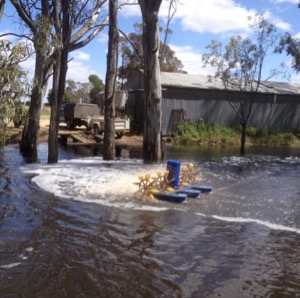The images of thousands of dead fish in the Darling River in recent media have shocked many and led to calls for action.
The loss of these fish will have a devastating impact on our native fish populations and with the heatwave conditions forecast for this week it is likely that algal blooms will occur elsewhere in the river system. Mass death events such as this, however, have happened before. Professor Robyn Watts at the Charles Sturt University (CSU) Institute for Land, Water and Society describes an event in 2016 that we can draw comparisons to.
"We can draw from our experience of a hypoxic blackwater event in the Murray River in 2016, where a lot of fish died due to low dissolved oxygen (DO) concentrations following a large flood. While this event was not caused by an algal bloom (it was due to high concentrations of dissolved carbon in the water) the outcome of low DO and subsequent fish deaths was similar to what is currently occurring in the Darling River," Professor Watts said.
 Professor Watts said in 2016 local land owners and community members decided to take action and installed aerators to create fish refuges so that small populations of fish and other freshwater animals could survive.
Professor Watts said in 2016 local land owners and community members decided to take action and installed aerators to create fish refuges so that small populations of fish and other freshwater animals could survive.
"Water managers were also able to call on water from nearby irrigation canals to provide environmental flows and create small refuges with higher dissolved oxygen. There is evidence that these actions helped a small number of fish and other aquatic organisms to survive. Whilst these local actions did not prevent further fish deaths occurring outside the created refuges, the individual fish that did survive will have contributed to the recovery of the river ecosystem in the years following the event.
It needs to be understood though, that the lack of water in Menindee Lakes to provide flows will make it more difficult to create small refuges in the case of the Darling River," Professor Watts said.
Despite this, Professor Watts said there is an opportunity for locals along the Darling River to adopt a strategy similar to that undertaken in 2016.
"During previous hypoxic events the community felt powerless and were devastated when they observed fish dying. However, during the 2016 hypoxic event they rallied around and installed these aerators that had the potential to make a small difference.
Local actions such as these could be initiated in other parts of the Darling River before the algal bloom spreads further and DO concentrations drop too low. It is essential to initiate actions before the algae bloom spreads to these downstream sites or new outbreaks arise elsewhere," Professor Watts said.
Photo credit: Paddle wheel aerator in operation in the Edward River in 2016 (Photo supplied by Luke Pearce).






